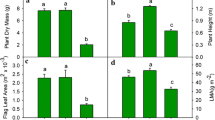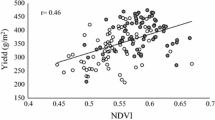Summary
Sixty-seven inbred lines of maize were evaluated for resistance to low-temperature photoinhibition of photosynthesis, using a pulse-modulated chlorophyll fluorescence technique. The evaluation procedure was based on leaf discs, which were exposed to a high irradiance (1000 µmol/m2/s) at 7°C. The efficiency of open PSII reaction centres as a reflection of overall photosynthesis was measured before and after a photoinhibition-inducing treatment. Exposure of leaf discs to photoinhibitory condition for 2, 4, and 8 hours resulted in an efficiency reduction of 30, 53 and 83%, respectively. Testing of inbred lines showed large differences for photoinhibition susceptibility. The difference in photosynthetic efficiency between the most extreme lines after a treatment of eight hours was 39%. Resistance to photoinhibition was shown to be relevant under cool field conditions. It proved to be a trait strongly amenable to selection.
Similar content being viewed by others
References
Baker, N.R., M., Bradbury, P.K., Farage, C.R., Ireland & S.P., Long, 1989. Measurements of the quantum yield of carbon assimilation and chlorophyll fluorescence for assessment of photosynthetic performance of crops in the field. Phil. Trans. R. Soc. London B 323: 295–308.
Baker, N.R., T.M., East & S.P., Long, 1983. Chilling damage to photosynthesis in young Zea mays. II. Photochemical function of thylakoids in vivo. Journal of Experimental Botany 34: 189–197.
Baker, N.R., S.P. Long & D.R. Ort, 1988. Photosynthesis and temperature with particular reference to effects on quantum yield. In: S.P. Long & F.I. Woodward (Eds). Plants and temperature. Symposia of the Society of Experimental Biology 42: 347–375.
Crevecoeur, M. & J.F., Ledent, 1984. Effets de basses températures (0–10° C) sur la croissance juvénile du maïs: quelques aspects de recherche fondamentale. Bulletin de la Société Royale de Botanique de Belgique 117: 382–412.
Dolstra, O., M.A. Jongmans & K. de Jong, 1988. Improvement and significance to low-temperature damage in maize (Zea mays L.). I. Chlorosis resistance. Euphytica S: 117–123.
Havaux, M. & R., Lannoye, 1984. Effects of chilling temperatures on prompt and delayed chlorophyll fluorescence in maize and barley leaves. Photosynthetica 18: 117–127.
Hetherington, S.E., J., He & R.M., Smillie, 1989. Photoinhibition at low temperature in chilling-sensitive and-resistant plants. Plant Physiology 90: 1609–1615.
Hetherington, S.E. & G., Öquist, 1988. Monitoring chilling injury: a comparison of chlorophyll fluorescence measurements, postchilling growth and visible symptoms of injury in Zea mays. Physiologia Plantarum 72: 241–247.
Hetherington, S.E., R.M., Smillie, H.A., Eagles & A.K., Hardacre, 1983. Using chlorophyll fluorescence in vivo to measure the chilling tolerances of different populations of maize. Australian Journal of Plant Physiology 10: 247–256.
Genstat 5 Committee, 1987. Reference Manual. Clarendon Press, Oxtord, 749 pp.
Greer, D.H. & A.K., Hardarce, 1989. Photoinhibition of photosynthesis and its recovery in two maize hybrids varying in low temperature tolerance. Australian Journal of Plant Physiology 16: 189–198.
Miedema, P., 1982. The effect of low temperature on Zea mays. Advances in Agronomy 35: 93–128.
Miedema, P., J. Post & P.J. Groot, 1987. The effects of low temperature on seedling growth of maize genotypes. Agricultural Research Reports 926, 124 pp.
Long, S.P., T.M., East & N.R., Baker, 1983. Chilling damage to photosynthesis in young Zea mays. I. Effects of light and temperature variation on photosynthetic CO2 assimilation. Journal of Experimental Botany 34: 177–188.
Ortiz-Lopez, A., G.Y., Nie, D.R., Ort & N.R., Baker, 1990. The involvement of the photoinhibition of photosystem II and the impaired membrance energetization in the reduced quantum yield of carbon assimilation in the chilled maize. Planta 181: 78–84.
Schapendonk, A.H.C.M., P.E.L.van der, Putten, W.J.M., Tonk, O., Dolstra & S.R., Haalstra, 1992. Chlorophyll fluorescence: a nondestructive method for detecting damage in the photosynthetic apparatus in plants. Acta Horticultuae 304: 17–32.
Schreiber, U., 1986. Detection of rapid induction kinetics with a new type of high-frequency modulated chlorophyll fluorometer. Photosynthesis Research 9: 261–272.
Schreiber, U. & W., Bilger, 1985. Rapid assessment of stress effects on plant leaves by chlorophyll fluorescence measurements. NATO ASI series Vol. G15: 1–25.
Stamp, P., 1984. Chilling tolerance of young plant demonstrated on the example of maize (Zea mays L.). Fortschritte im Acker-und Pflanzenbau No 7, 83 pp.
Taylor, A.O. & J.A., Rowley, 1971. Plants under climatic stress. 1. Low temperature, high light effects on photosynthesis. Plant Physiology 47: 713–718.
Van, Kooten, O. & J.F.H., Snel, 1990. The use of chlorophyll fluorescence nomenclature in plant stress physiology. Photosynthesis Research 25: 147–150.
Author information
Authors and Affiliations
Rights and permissions
About this article
Cite this article
Dolstra, O., Haalstra, S.R., van der Putten, P.E.L. et al. Genetic variation for resistance to low-temperature photoinhibition of photosynthesis in maize (Zea mays L.). Euphytica 80, 85–93 (1994). https://doi.org/10.1007/BF00039302
Received:
Accepted:
Issue Date:
DOI: https://doi.org/10.1007/BF00039302




